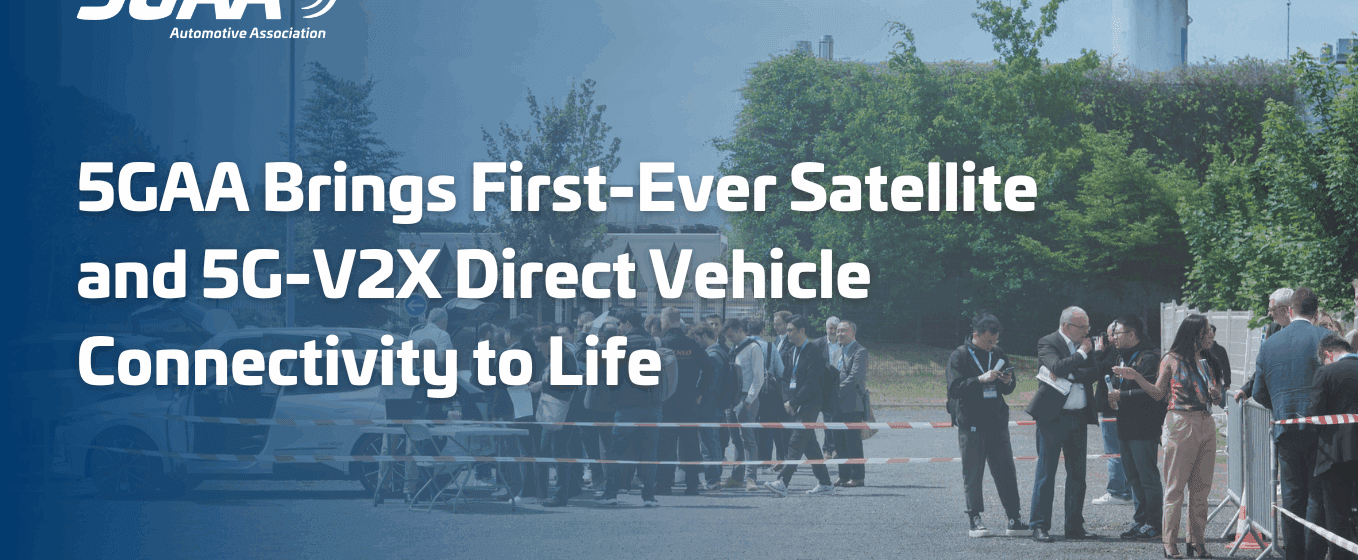
5GAA Tech Demos in Paris: 5GAA Brings First-Ever Satellite and 5G-V2X Direct Vehicle Connectivity to Life
In a global premiere in May 2025, the 5G Automotive Association (5GAA) demonstrated connected vehicles using non-terrestrial networks (NTN) complementing terrestrial 4G and 5G networks for emergency messaging. It also did the first on-the-road, live-traffic demonstration of 5G-V2X Direct technology capabilities for advanced connected-vehicle services and ready-to-deploy vehicle-to-network (V2N) technologies, which can improve road safety in real traffic conditions.
Missed the demos? No problem! Now you can see the replay of these advanced vehicle technologies! Watch the full video below to experience the demos in action!
5GAA-member vehicle manufacturers BMW Group and Stellantis and technology partners Anritsu, Cubic³, Deutsche Telekom, HARMAN, Jember, LG Electronics, Qualcomm Technologies, MediaTek, Rohde & Schwarz, Rolling Wireless, Skylo, VEDECOM Institute, and Viasat participated in the NTN satellite connectivity demonstrations. The demos focused on realising hazard warning and emergency messaging use cases in the vehicle as well as illustrating how NTN will complement terrestrial 4G and 5G networks in the future.
Demonstrations on public roads underlined how NTN can support ubiquitous automotive connectivity for connected services with seamless integration and switching between NTN and terrestrial networks to enable voice communication. In the future, car drivers may not even realise that satellite connectivity has replaced a terrestrial network. According to the 5GAA 2030 Roadmap, the initial market deployment of satellite connectivity in vehicles is expected by 2027 (based on IoT NTN 3GPP Release 17).
Anritsu, Keysight Technologies, Rohde & Schwarz, and MediaTek complemented the NTN demonstrations with parallel test equipment measurements for performance verification.
For the first time on public roads, 5GAA member Valeo, in collaboration with Marben, demonstrated 5G-V2X Direct, in which two vehicles shared sensor data, triggering a warning of a pedestrian crossing at an obstructed intersection. This demonstration illustrated how 5G-V2X Direct (based on 3GPP Release 16) will enable vulnerable road users’ advanced protection by leveraging sensors and camera feeds from other vehicles to alert drivers, paving the way for smarter mobility. As per the 5GAA Visionary 2030 Roadmap, 5G-V2X is expected to be mass-deployed in commercial vehicle models starting from the time horizon 2026-2029.
The public road demonstrations continued with V2N technology for road users’ protection. 5GAA members, including Nokia, Orange, Stellantis, Valeo, and VEDECOM Institute, showcased interoperable V2X Platforms with vehicles, mobile applications and smart intersections (equipped with cameras and connected via the 5G networks) sharing collective perception to enhance road users’ safety.
Additionally, HARMAN and u-blox showcased Emergency Electronic Brake Light (EEBL) near-real-time alerts to prevent hard braking events in line with the upcoming 2026 Euro NCAP local hazard warning requirements, and used precise positioning techniques to prevent false alerts.
5GAA members Rohde & Schwarz, S.E.A., Keysight and Orange also exhibited Next Generation Emergency Call (NG eCall) verification and network performance.
The event, hosted by Telecom-Paris, highlighted how 5GAA is driving the development of new standards for safety and innovation in automotive connectivity in Europe and globally.
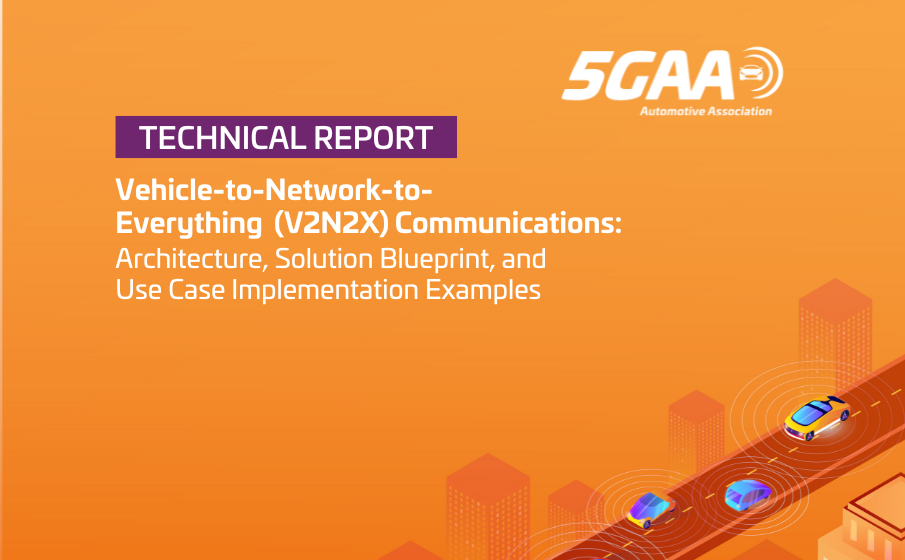
Vehicle-to-Network-to-Everything (V2N2X) Communications: Architecture, Solution Blueprint, and Use Case Implementation Examples
This technical report builds on the 5GAA white paper “Road traffic operation in a digital age” and guides stakeholders on implementing various vehicle-to-everything (V2X) applications using cellular networks and information sharing structures between backend systems.
It presents an application-level reference blueprint architecture and introduces an “information sharing domain” to enable scalable digital data exchange among stakeholders such as vehicle manufacturers, service providers, and infrastructure operators. The report details how to implement V2X applications that enhance safety and mobility, with examples including traffic event and signal information sharing, emergency vehicle approaching alerts, automated valet parking, and vulnerable road user protection. It also explains different implementation options for these applications within vehicles, distinguishing between OEM-controlled, OEM-supported, and OEM-independent apps.
Additionally, it describes proven solutions and references initial deployments like C-Roads and Talking Traffic, highlighting their effectiveness in accelerating V2X service adoption. Ecosystem stakeholders are encouraged to use this document as a guide for deploying V2X services using cellular networks and information sharing, with the potential to address more demanding use cases through enhanced cellular network capabilities.
Read the full report here.
For more information, find the complementary technical report “Business Perspectives on Vehicle-to-
Network-to-Everything (V2N2X) Deployments.”
A 5GAA online session on the V2N2X topic and reports took place on 18 June 2024. The recording of the online session can be accessed here. The slides of the presentation can be accessed here.
The paper was originally published in May 2024. The current downloadable version is the updated edition, released on 3 June 2025. 5GAA remains committed to keeping all its publications accurate and up to date.
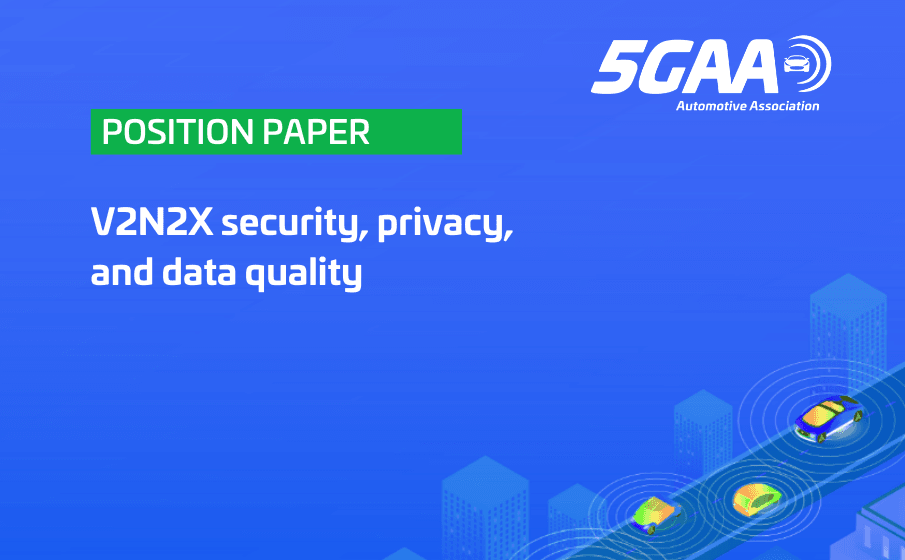
V2N2X security, privacy, and data quality
Cellular Vehicle-to-Everything, or C-V2X, is an umbrella term that encompasses all 3GPP V2X technologies, including both direct (PC5) and mobile network communications (Uu). In many cases, both direct and network modes of C-V2X can be used for the same or similar automotive and Intelligent Transport System (ITS) applications, yet with different service characteristics. However, there are fundamental differences when it comes to the architecture and realisation of different Use Cases applying mobile network vs. direct, short-range, communications. This leads to different ways of handling security, privacy, and how to ensure data quality – the fundamental requirements of every ITS service – when using C-V2X mobile network communication or direct communication. This is already reflected in other organisations such as ITS America.
This 5GAA paper provides an overview of how security, privacy, and data quality are addressed for C-V2X using mobile network and backend communications, also known as Vehicle-to-Network-to-Everything (V2N2X) solutions.
The paper was originally published in December 2024. The current downloadable version is the updated edition, released on 3 June 2025. 5GAA remains committed to keeping all its publications accurate and up to date.
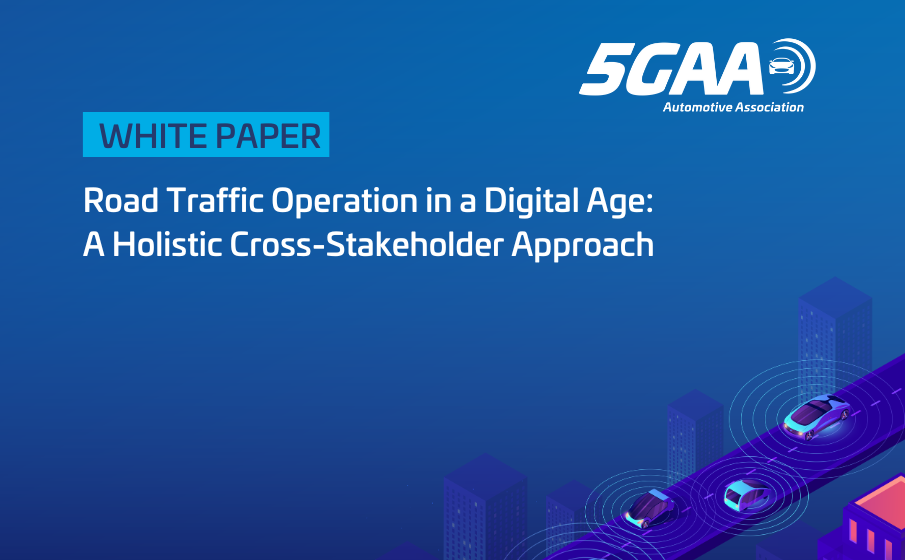
Road Traffic Operation in a Digital Age: A Holistic Cross-Stakeholder Approach
The societal ambitions of zero fatalities and climate neutrality in road transportation, as well as future ambitions of automated driving require a new approach to the handling of road traffic information. The key stakeholders of the ecosystem, global automotive OEMs, service providers (SPs) and infrastructure owner-operators (IOOs), need new digital methods of operating and interworking.
This white paper proposes a transformative approach for automotive stakeholders, emphasizing scalable digital data exchange and a federated architecture to manage road traffic information efficiently. The architecture ensures bidirectional communication, delivering static, semi-static, and near real-time data for safe and efficient transportation. The paper concludes with recommendations for a National Roadway Digital Strategy, federated information-sharing structures, and aligned investments. Emphasising the integration of technologies and data-driven decision-making, it aligns with 5GAA’s mission to propel road traffic operations into the digital age.
Read or download the full white paper here.
The paper was originally published in January 2024. The current downloadable version is the updated edition, released on 3 June 2025. 5GAA remains committed to keeping all its publications accurate and up to date.
Note: To complement this white paper with further technical details and business considerations, 5GAA has developed two technical reports and one position paper:
- Technical Report “Vehicle to Network to Everything (V2N2X) Communications; Architecture, Solution Blueprint, and Use Case Implementation Examples”: This technical report describes for different ecosystem stakeholders how to realise various V2X applications and use cases (UCs), using cellular network communications in combination with information sharing structures between backend systems. It also clarifies the different implementation options of the V2X application in a vehicle and their related implications. In this report, readers can also find verified V2N2X solutions and references to initial operational deployments that realize the suggested application-level reference architecture, e.g., C-Roads, Talking Traffic, Mobilidata, etc. The document is available here.
- Technical Report “Business Perspectives on Vehicle-to-Network-to-Everything (V2N2X) Deployments”: This technical report describes the V2N2X market from a business standpoint, encompassing market dynamics, stakeholder analysis, and business models deployed in various exemplary instances. The document is available here.
- Position paper “V2N2X security, privacy, and data quality”: This position paper provides an overview of how security, privacy, and data quality are addressed for C-V2X using mobile network and backend communications, with highlights on the different characteristics and approaches in comparison with C-V2X direct communications. The document is available here.
A 5GAA online session on the V2N2X topic and reports took place on 18 June 2024. The recording of the online session can be accessed here. The slides of the presentation can be accessed here.

Driving the Future: 5GAA Brings First-Ever Satellite and 5G-V2X Direct Vehicle Connectivity to Life in Paris
- In a global premiere, 5GAA members demonstrated connected vehicles using non-terrestrial networks (NTN), complementing terrestrial 4G and 5G networks
- The event featured the first on-the-road, live-traffic demonstration of 5G-V2X Direct technology capabilities for advanced connected mobility services
- 5GAA members showcased ready-to-deploy vehicle-to-network (V2N) technologies improving road safety in real traffic conditions
PARIS, 15 May 2025 — For the first time worldwide, the 5G Automotive Association (5GAA) showcased connected vehicles using non-terrestrial networks (NTN) for emergency messaging, as well as 5G-V2X Direct for advanced detection of vulnerable road users (VRU) in real-traffic conditions. 5GAA members also demonstrated the readily available capabilities of Vehicle-to-Network (V2N) services.
“Today, we saw real vehicles on real roads, connected through cutting-edge technologies such as satellite, 5G-V2X Direct and commercial networks. This is the future of automotive connectivity, and it’s closer than you think,” said 5GAA Chairman Christoph Voigt.
5GAA members, vehicle manufacturers BMW Group and Stellantis and technology partners Anritsu,Cubic³, Deutsche Telekom, HARMAN, Jember, LG Electronics, Qualcomm Technologies, MediaTek, Rohde & Schwarz, Rolling Wireless, Skylo, VEDECOM Institute and Viasat demonstrated NTN satellite connectivity. Demonstrations focused respectively on realising hazard warning and emergency messaging use cases in the vehicle, as well as illustrating how NTN will complement terrestrial 4G and 5G networks in the future. Demonstrations on public roads emphasised the vision of how NTN can support ubiquitous automotive connectivity for connected services with seamless integration and switching between NTN and terrestrial networks to enable voice communication. In the future, car drivers may not even realise that satellite connectivity is being established instead of using a terrestrial network. According to 5GAA 2030 Roadmap, the initial market deployment of satellite connectivity in vehicles is expected by 2027 (based on IoT NTN 3GPP Release 17).
Anritsu, Keysight Technologies, Rohde & Schwarz, and MediaTek complemented the NTN demonstrations with parallel test equipment measurements for performance verification.
For the first time on the road, 5GAA member Valeo, in collaboration with Marben, demonstrated 5G-V2X Direct, in which two vehicles shared sensor data, triggering a warning of a pedestrian crossing at an obstructed intersection. This demonstration illustrated how 5G-V2X Direct (based on 3GPP Release 16) will enable vulnerable road users’ advanced protection by leveraging sensors and camera feeds from other vehicles to alert drivers, paving the way for smarter mobility. As per the 5GAA Visionary 2030 Roadmap, 5G-V2X is expected to be mass-deployed in commercial vehicle models starting from the time horizon 2026-2029.
The public road demonstrations continued with V2N technology for road users’ protection. 5GAA members, including Nokia, Orange, Stellantis, Valeo, and VEDECOM Institute, showcased interoperable V2X Platforms with vehicles, mobile applications and smart intersections (equipped with cameras and connected via the 5G networks) sharing collective perception to enhance road users’ safety. Additionally, HARMAN and u-blox showcased Emergency Electronic Brake Light (EEBL) near-real-time alerts to prevent hard braking events, in line with the upcoming 2026 Euro NCAP local hazard requirements, and used precise positioning techniques to prevent false alerts.
5GAA members Rohde & Schwarz, S.E.A., Keysight and Orange alsoexhibited Next Generation Emergency Call (NG eCall) verification and network performance.
The event, hosted by Telecom-Paris, highlighted how 5GAA is developing new standards for safety and innovation in automotive connectivity in Europe and globally.
Please see our brochure about the Paris demonstrations here.
A French version of this press release is also available for our French-speaking audience here.
Discover What Our 5GAA Members Are Saying here.
About the 5GAA
The 5G Automotive Association (5GAA) is a global, cross-industry organisation of more than 110 members, including leading global automakers, Tier-1 suppliers, mobile operators, semiconductor companies, and test equipment vendors. 5GAA members work together to develop end-to-end solutions for future mobility and transport services. 5GAA is committed to helping define and develop the next generation of connected mobility, automated vehicles, and intelligent transport solutions based on C-V2X. For more information about 5GAA, please visit www.5gaa.org.

5GAA Conference: France 2030 & Beyond: Accelerating Connected Mobility
On 15 May 2025, the 5G Automotive Association (5GAA) will host a full day of high-level discussions and real-world demonstrations in Paris, spotlighting the latest V2X innovations in France and across Europe.
Key Topics
The day will begin with the “France 2030 & Beyond: Accelerating Connected Mobility” conference at La Défense. This conference will gather key industry leaders, policymakers, and regulatory experts to discuss the future of V2X in France and Europe, focusing on cooperative, connected, and automated mobility (CCAM).
Discussions will focus on accelerating the market deployment of CCAM technologies and the key enablers needed for future mobility. Highlights include expert panels on what the automotive industry needs to scale connected mobility services and the role of Non-Terrestrial Networks (NTN) in delivering large-scale, reliable V2X solutions.
Experience the Technology
In the afternoon, participants will travel to Paris-Saclay, to experience first-hand the latest C-V2X innovations by 5GAA members in the Paris Télécom University area:
- First-ever demonstration of NTN technology applications for the automotive sector, allowing for seamless ubiquitous connectivity.
- Vehicle-to-Network (V2N) services showcase for Vulnerable Road Users’ protection at intersections and safety alerts between vehicles in case of hard braking ahead, toemphasize the market readiness and fast-scaling potential of network-based technologies.
- First-ever on-road 5G-V2X Direct (3GPP Release 16) demonstration of sensor-sharing between vehicles for Vulnerable Road Users (VRU) detection at an obstructed intersection, on-road and in real-traffic conditions.
Please see our brochure about the Paris demonstrations here:
https://5gaa.org/content/uploads/2025/05/5gaa-paris-demos-media-kit-14.05.2025.pdf
Media contact: marcom@5GAA.org

5GAA to Host High-Level Conference and Live Demos in Paris
On 15 May 2025, the 5G Automotive Association (5GAA) will host a full day of high-level discussions and real-world demonstrations in Paris, spotlighting the latest V2X innovations in France and across Europe.
Key Topics
The day will begin with the “France 2030 & Beyond: Accelerating Connected Mobility” conference at La Défense. This conference will gather key industry leaders, policymakers, and regulatory experts to discuss the future of V2X in France and Europe, focusing on cooperative, connected, and automated mobility (CCAM).
Discussions will focus on accelerating the market deployment of CCAM technologies and the key enablers needed for future mobility. Highlights include expert panels on what the automotive industry needs to scale connected mobility services and the role of Non-Terrestrial Networks (NTN) in delivering large-scale, reliable V2X solutions.
Experience the Technology
In the afternoon, participants will travel to Paris-Saclay, to experience first-hand the latest C-V2X innovations by 5GAA members in the Paris Télécom University area:
- First-ever demonstration of NTN technology applications for the automotive sector, allowing for seamless ubiquitous connectivity.
- Vehicle-to-Network (V2N) services showcase for Vulnerable Road Users’ protection at intersections and safety alerts between vehicles in case of hard braking ahead, toemphasize the market readiness and fast-scaling potential of network-based technologies.
- First-ever on-road 5G-V2X Direct (3GPP Release 16) demonstration of sensor-sharing between vehicles for Vulnerable Road Users (VRU) detection at an obstructed intersection, on-road and in real-traffic conditions.
Stay tuned for more information, event highlights and key takeaways, which will be shared on the 5GAA website and social media following the conference!
If you wish to participate, contact us at marcom@5gaa.org.
We look forward to welcoming you to Paris for this groundbreaking event!
Exclusive Media Tour!
Join us In Paris!
The 5GAA’s tech demonstrations offer an unparalleled opportunity to learn from industry leaders and explore the future of automotive connectivity.
If you would like to attend physically the media tour from 10:30 to 12:30 pm CEST or request interviews with key speakers and experts, please contact us at marcom@5gaa.org
For further information
Please see our brochure about the Paris demonstrations here:
https://5gaa.org/content/uploads/2025/05/5gaa-paris-demos-media-kit-14.05.2025.pdf
Media contact: marcom@5GAA.org
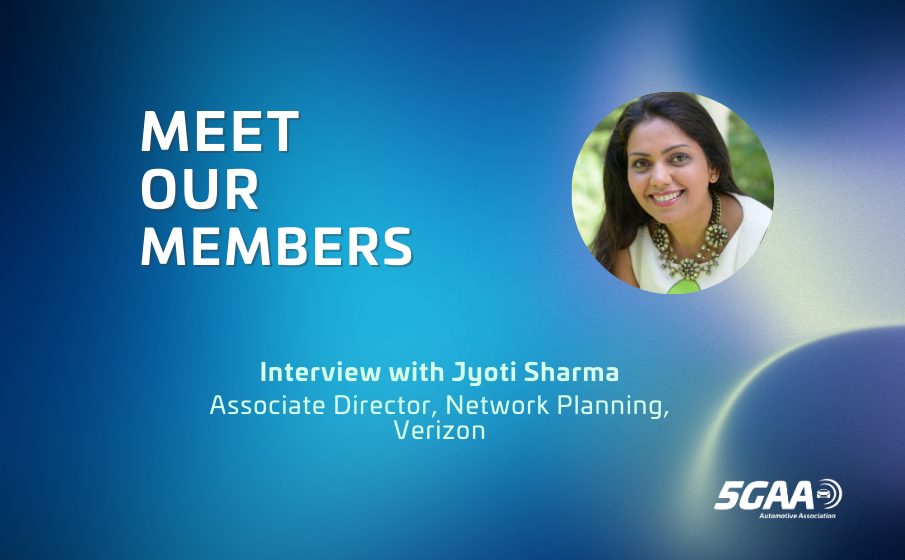
Meet Our Members – Interview with Jyoti Sharma, Verizon
In our ongoing “Meet Our Members” series, we explore the unique journeys and expertise of the individuals who make the 5G Automotive Association. Each interview sheds light onto the incredible work, vision, and passion of the people behind our organisation. You can check out our last conversation with Menno Malta, CEO of Monotch, here.
This time, we introduce Jyoti Sharma, Associate Director of Network Planning at Verizon and alternate board member at 5GAA since 2021. Jyoti has brought her deep industry insight to a range of work items, including Vehicle-to-Network-to-Everything (V2N2X) and has led initiatives such as the Vulnerable Road User (VRU) Demo. Her commitment to accelerating the large-scale deployment of V2X technologies make her a valuable contributor to the 5GAA, and we’re excited to learn more about her perspective on the future of 5G and MEC in transportation.
Could you tell us briefly about Verizon’s involvement in 5GAA and how your company benefits from being a member?
Verizon has been an active member of 5GAA since its inception. We started out as a general member and initially contributed at the working group level. We saw tremendous value in taking a leadership role in 5GAA as a major U.S. telecommunications provider and were elected by the members as a gold board member in 2021. Currently, Verizon is a platinum board member of 5GAA and we are playing a critical strategic role as one of the key stakeholders in the V2X ecosystem.
When did you first become part of the 5GAA board? What are some of your responsibilities, and what has been your most rewarding experience so far?
I represent Verizon on the 5GAA board as an alternate board member since 2021. In my role as a board member I have the privilege and responsibility to ensure 5GAA remains focused on key strategic focus areas which will accelerate a large-scale deployment of Vehicle-to-Everything (V2X) across the globe. My most rewarding experience has been to collaborate with other 5GAA members who are leaders from auto OEM customers, their tier 1 suppliers, chipset and module providers and other ecosystem partners. This technical collaboration between all the stakeholders is the key to drive innovation and unlock the full potential of V2X communications at scale and make it a reality.
Can you share any recent examples of how Verizon has collaborated with other 5GAA members to drive innovation in the industry?
Verizon has taken a leadership role in bringing the V2X ecosystem partners together under the 5GAA umbrella. We have demonstrated thought leadership in defining the network architecture to solve challenging V2X requirements leveraging key technology enablers such as 5G, multi-access edge computing (MEC) and Hyper Precise Location. Our recent V2X VRU (Vulnerable Road User) demo in Detroit showcasing interoperability between different network operators and application providers generated a very positive response and engagement from auto OEMs, Departments of Transportation and road operators. The demo was successful due to close collaboration with several 5GAA member companies.
As the lead of the VRU DEMO Work Item, could you elaborate on the significance of demonstrating interoperability in the context of Vulnerable Road User protection solutions?
VRU DEMO is one of the key strategic focus areas at the 5GAA board level that the industry has been trying to address for many decades. We believe the C-V2X and other technology enablers (5G, MEC, Hyper Precise Location) are ready to mitigate the number of road accidents involving vulnerable road users such as pedestrians and cyclists. In order to deploy such a VRU solution at scale it needs to work across multiple operators, multiple auto OEMs, multiple application providers and multiple cloud providers. We reached a significant milestone by demonstrating interoperability amongst different stakeholders and showcased the technology is ready to deploy at scale with existing networks. The learnings from the demo are being replicated in other parts of the world and are informing U.S. DOT V2X Deployment plans.
What criteria were used to select the specific use cases for demonstration in VRU DEMO? How did these use cases represent real-world scenarios and challenges?
There has been extensive discussion within 5GAA to define different VRU scenarios. Different flavors of VRU use cases have been documented in published technical reports. The demo team carefully selected most common real world VRU scenarios such as active pedestrian crossing alert and using roadside cameras and artificial intelligence, machine learning logic in the MEC to detect pedestrians and alert the drivers to avoid potential collision.
Verizon participated in the demos with a showcase of its network solution using multi-access edge computing. How does MEC differ from traditional network-based computing in terms of its benefits for VRU protection applications?
MEC allows us to bring traditional cloud compute and storage within the mobile network closer to the edge where the data is generated reducing the end to end latency. It is well established that MEC is a key differentiator and technology enabler for latency critical use cases such as VRU protection. Verizon has already deployed public MEC across the United States in partnership with cloud providers. We continue to drive innovation by developing standard MEC and Network APIs for application providers. During the VRU demo we demonstrated near real time VRU alerts over 5G and applications hosted on Verizon’s Detroit MEC.

Meet Our Members – Interview with Menno Malta, Monotch CEO
The 5G Automotive Association (5GAA) thrives on the collective expertise and collaborative spirit of its members. Over 110 organisations strong, our membership represents a global network of market leaders and innovators shaping the future of connected mobility.
We are kicking off a new series, “Meet Our Members,” to delve deeper into the stories of the individuals who make up the backbone of 5GAA. First up, we will be featuring Menno Malta, CEO of Monotch, who has been actively involved in one of 5GAA’s most recent and exciting areas of work – Vehicle-to-Network-to-Everything (V2N2X) communication.
This interview series will showcase a diverse range of profiles, highlighting their contributions, challenges, and predictions for the exciting world of 5G-connected transportation. Get ready to be inspired by the passion and ingenuity of our members as we meet the people who make 5GAA.
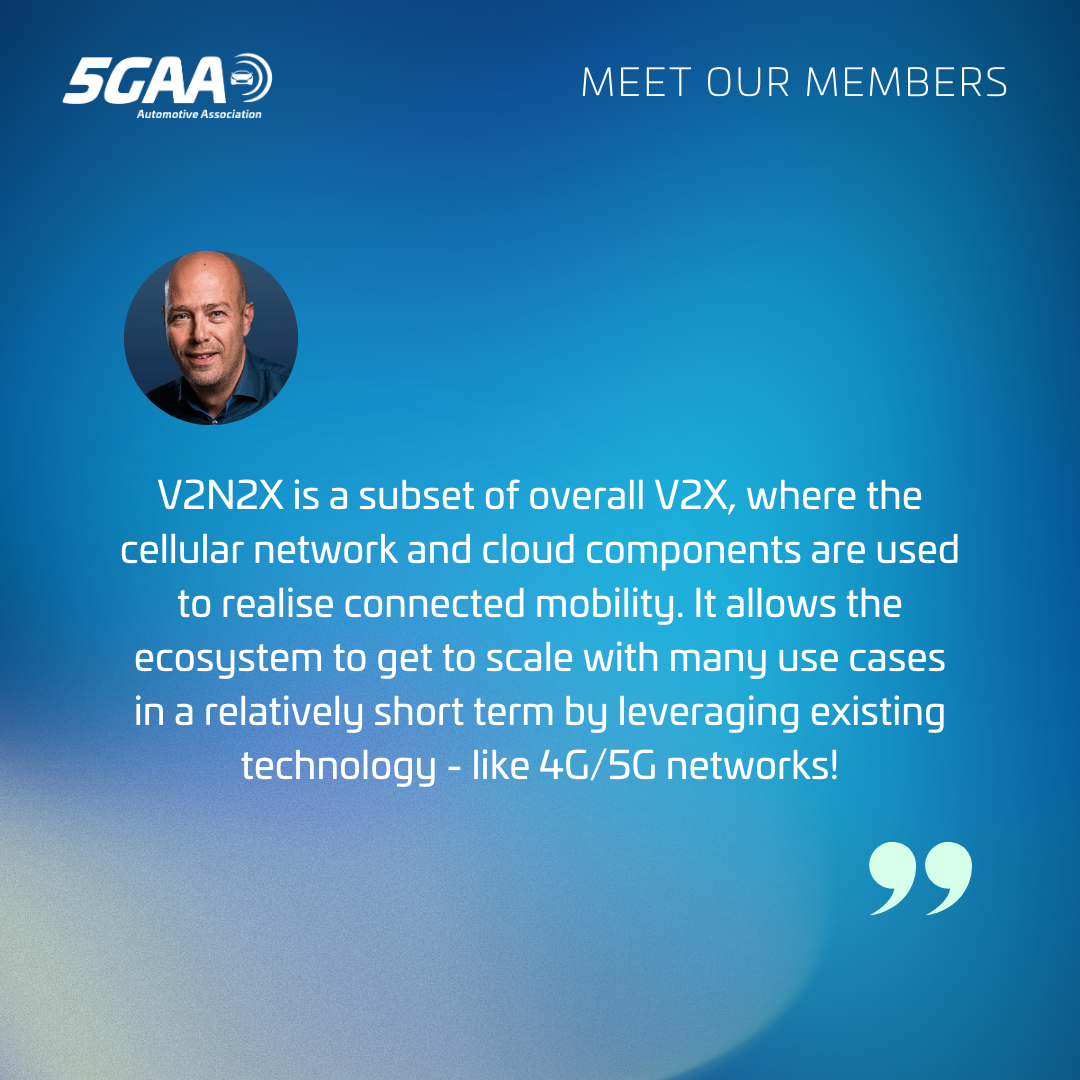
Menno, you are the CEO of Monotch, a 5GAA member company. How does Monotch’s work relate to 5GAA’s, and what keeps you engaged with our association?
Monotch operates at the forefront of the V2N2X market. Our proven TLEX platform is used by cities and road authorities all over the world to connect mobility and digital infrastructure bringing substantial societal benefits and increased cost-effectiveness.
The initial interest that drew us to 5GAA was the opportunity to engage with OEMs, mobile network operators, and related industries. This is still of interest! We really appreciate the possibilities to discuss developments and work jointly on progressing the market. The networking opportunities are also great for us.
Monotch is based in the Netherlands. Last year, your views were instrumental in the organisation of 5GAA’s workshop in the Hague, where we looked at C-V2X deployment in the Low Countries. Two years later, what is the state of play for C-V2X and connected mobility in the Netherlands, and how do you see it unfolding?
In the Netherlands, we see a steady growth of smart and connected roadside infrastructure as well as new use cases such as emergency vehicle warnings that are now available on a large scale. This leads to more connected parties, including the first vehicle OEMs. On top of this, there is a push on urban challenges and use cases, which will lead to even more data and impact in the next few years. The Netherlands is truly a lighthouse deployment, and authorities from other countries come here often to see what’s happening and how they can apply learnings in their own jurisdiction.
One of 5GAA’s recent areas of work has been vehicle-to-network-to-everything (V2N2X) communications, and you’ve been one of its main contributors. What is V2N2X, what makes this such an important topic, and what are some of the biggest hurdles to overcome in achieving its widespread adoption?
V2N2X is a subset of overall V2X, where the cellular network and cloud components are used to realise connected mobility. It allows the ecosystem to get to scale with many use cases in a relatively short term, as it leverages existing technology such as apps, onboard units and, of course, the 4G/5G network! I think it’s hugely important for 5GAA as it shows the value of a connected ecosystem to the main stakeholders and can kickstart overall C-V2X deployment.
The V2N2X work item has been concluded with the publication of a white paper, ‘Road Traffic Operation in a Digital Age,’ and two associated reports. What is the objective of these publications, and how do they complement each other?
The white paper can be seen as a summary of the Technical V2N2X Architecture report. It’s a great read for everyone involved in this market, whether you’re an authority or a private sector executive. The Technical V2N2X Architecture report offers detailed insights into the blueprint architecture, and I recommend it to subject matter experts.
The other technical report is of a different nature. It describes the V2N2X market from a business perspective—for example, the market size, the kinds of business models we see, and which factors drive the market. It also contains descriptions of large-scale example deployments, taking away whatever doubts people might have about the feasibility of V2N2X..
The upcoming online session on 18 June will present the findings of these publications. What are you most excited about sharing with the audience?
So much to share! I can promise the session will be packed with insights, but I’m probably most excited to share the OEM and IOO (Infrastructure Owner and Operator) customer profiles we created. It’s about their goals, pains and gains, and for this, we did a survey and an analysis of large-scale deployments. I’m so excited about it because it really ties to the why of our work.
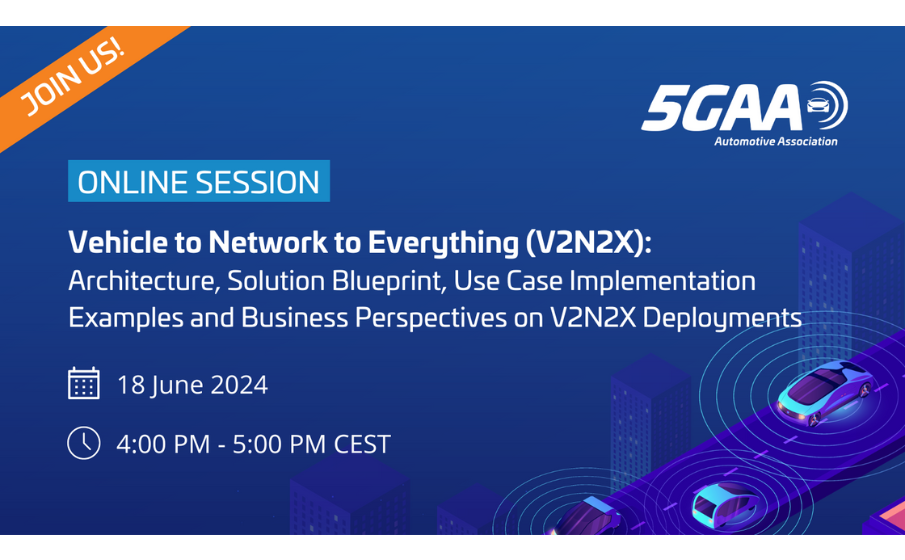
5GAA online session on V2N2X: Architecture, Solution Blueprint, Use Case Implementation Examples & Business Perspectives
In January 2024, 5GAA published the white paper “Road Traffic Operation in a Digital Age: A Holistic Cross-Stakeholder Approach”. The white paper proposes a transformative approach for automotive stakeholders, emphasising a scalable digital data exchange and a federated architecture to manage road traffic information efficiently. It outlines a data sharing and deployment architecture for road traffic management information in a digital twin structure.
This white paper has now been complemented with two Technical Reports (TRs), providing additional technical details, deployment options, reference implementations and business aspects. The online session will provide valuable insights into both reports.
A 5GAA online session on the V2N2X topic and reports took place on 18 June 2024. The recording of the online session can be accessed here. The slides of the presentation can be accessed here.


